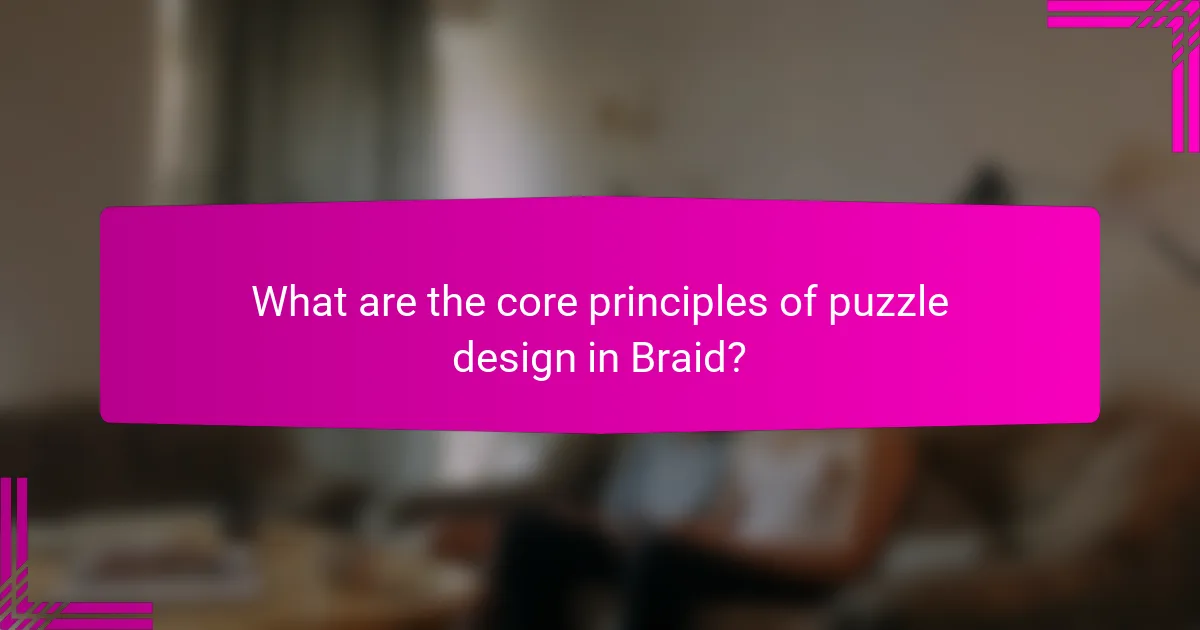Braid offers a unique gaming experience through its innovative narrative structure, intricate puzzle design, and distinctive artistic style. The game intertwines storytelling with gameplay mechanics, using time manipulation to deepen emotional connections. Its puzzle design emphasizes player agency and critical thinking, while the hand-painted visuals create an immersive atmosphere. Together, these elements challenge conventional gameplay and enhance player engagement.

How does Braid’s narrative structure enhance player engagement?
Braid’s narrative structure enhances player engagement by intertwining storytelling with gameplay mechanics. The unique time-manipulation mechanic allows players to experience the narrative from multiple perspectives, deepening emotional connections. This innovative approach encourages exploration and reflection, making players actively invest in the story. The layered storytelling, combined with artistic style, creates a rich environment that captivates and challenges players, fostering a memorable gaming experience.
What are the key elements of Braid’s storytelling techniques?
Braid employs innovative storytelling techniques that intertwine narrative structure, puzzle design, and artistic style. Its non-linear narrative invites players to explore time manipulation, enhancing emotional depth. The puzzle design requires critical thinking, where mechanics reflect the story’s themes. Additionally, the artistic style features a distinct visual aesthetic that complements the narrative, creating an immersive experience. Each element reinforces the game’s unique approach to storytelling.
How do time manipulation mechanics influence the narrative?
Time manipulation mechanics significantly enhance the narrative by allowing players to experience events from multiple perspectives. This mechanic creates a non-linear storytelling approach, where actions in one time frame influence outcomes in another.
In “Braid,” players manipulate time to solve puzzles, revealing deeper layers of the story. Each level’s design connects gameplay with narrative, emphasizing themes of regret and redemption. As players rewind actions, they uncover the consequences of their choices, enriching the emotional depth of the experience.
This unique attribute of time manipulation not only challenges players intellectually but also invites them to reflect on the nature of time and memory. Thus, the narrative becomes an interactive exploration of complex themes, making the gameplay experience more immersive and thought-provoking.
What role do character development and dialogue play in the story?
Character development and dialogue are crucial in “Braid” as they enhance emotional engagement and narrative depth. The protagonist’s journey is intricately linked to the dialogue, revealing motivations and conflicts. This interplay drives the story forward, making the puzzles more meaningful. Each character’s unique traits contribute to the thematic exploration of time and consequence, enriching the overall experience.

What are the core principles of puzzle design in Braid?
The core principles of puzzle design in Braid focus on intertwining narrative and gameplay. Each puzzle reinforces the central theme of time manipulation, encouraging players to think critically about consequences. The design emphasizes player agency, allowing for multiple solutions and fostering exploration. Additionally, puzzles are crafted to align with the emotional journey, enhancing the storytelling experience. This integration of mechanics and narrative creates a unique gameplay dynamic that challenges perceptions of time and choice.
How does the integration of narrative and puzzles create a unique gameplay experience?
The integration of narrative and puzzles in Braid creates a unique gameplay experience by intertwining storytelling with problem-solving. This blend allows players to engage emotionally while challenging their cognitive skills. The narrative unfolds through time manipulation, reflecting themes of regret and redemption, enhancing the player’s connection to the puzzles. Each puzzle serves as a metaphor for the story, making the gameplay feel cohesive and meaningful. This approach elevates traditional puzzle mechanics, offering layers of depth that resonate with players beyond mere gameplay.
Which types of puzzles are most prevalent in Braid and why?
Braid features time-manipulation puzzles, platforming challenges, and narrative-driven enigmas. These types enhance gameplay by intertwining story and mechanics, creating a unique experience that emphasizes the consequences of player actions. The puzzles often require players to think critically about time and movement, reflecting the game’s core themes of memory and regret.
How does difficulty scaling affect player satisfaction?
Difficulty scaling significantly enhances player satisfaction by providing a balanced challenge that aligns with skill progression. In “Braid,” this design allows players to engage deeply with puzzles, fostering a sense of accomplishment. Gradual increases in complexity prevent frustration, encouraging exploration and mastery of mechanics. This approach also supports the narrative, as each level’s challenge reflects the story’s themes of time manipulation and consequence. Ultimately, effective difficulty scaling in “Braid” creates a rewarding experience, maintaining player engagement and satisfaction throughout the game.

In what ways does Braid’s artistic style contribute to its overall impact?
Braid’s artistic style significantly enhances its overall impact by creating an immersive atmosphere. The hand-painted visuals evoke a dreamlike quality, drawing players into its intricate world. This unique aesthetic complements the narrative structure, emphasizing themes of time and memory. The vibrant colors and detailed environments invite exploration, enriching the puzzle-solving experience. Braid’s artistic choices reinforce emotional engagement, making the gameplay memorable and thought-provoking.
How do visual aesthetics enhance storytelling in Braid?
Visual aesthetics significantly enhance storytelling in Braid by creating an immersive experience that complements the narrative. The game’s distinct art style, characterized by hand-painted visuals, evokes emotions and sets the tone. This artistic approach reinforces themes of time manipulation and memory, making the player’s journey more engaging. Additionally, the visual design aligns with puzzle mechanics, where each level’s aesthetic reflects its challenges, deepening player connection to the story. Ultimately, Braid’s visuals serve not only as decoration but as integral components that elevate the overall storytelling experience.
What artistic influences are evident in Braid’s design?
Braid’s design showcases influences from various artistic movements, particularly surrealism and impressionism. The game’s visual style employs vibrant colors and dreamlike landscapes, reflecting the fluidity of time and memory. Additionally, the intricate puzzle mechanics echo the complexity of narrative structures found in modern literature. Braid’s aesthetic draws on these influences to create an immersive experience that challenges players’ perceptions.
How does the use of color and light shape player perception?
The use of color and light significantly shapes player perception by influencing emotions and guiding attention. In “Braid,” vibrant colors and dynamic lighting create an immersive atmosphere, enhancing the narrative experience. Color choices convey mood, while light effects highlight puzzles and pathways, directing player focus. As a result, players engage more deeply with the story and gameplay, fostering a unique connection to the game’s artistic style.

Which unique features distinguish Braid from other indie games?
Braid distinguishes itself through its innovative narrative structure, intricate puzzle design, and unique artistic style. The game employs time manipulation mechanics that challenge conventional gameplay. Its storytelling intertwines with puzzles, creating a cohesive experience that deepens player engagement. Braid’s hand-painted visuals and atmospheric music enhance its emotional depth, setting it apart from typical indie games. Additionally, the game explores themes of regret and redemption, offering a thought-provoking experience rarely found in the genre.
What innovative gameplay mechanics set Braid apart?
Braid stands out due to its innovative time-manipulation mechanics that redefine puzzle-solving. Players can rewind time, allowing them to experiment with solutions and learn from mistakes. This mechanic creates a unique narrative structure, intertwining storytelling with gameplay. The artistic style complements this by presenting a visually striking world that enhances the emotional impact of the puzzles. Additionally, the game’s non-linear progression challenges traditional platforming norms, encouraging players to think critically about time and consequence.
How does Braid’s approach to time differ from other games?
Braid’s approach to time emphasizes manipulation and nonlinear progression, setting it apart from traditional games. Players can reverse time to solve puzzles, creating a unique narrative structure that intertwines gameplay and story. This mechanic allows for a deeper exploration of consequences and choices, enhancing emotional engagement. Unlike many other games that follow a linear timeline, Braid’s design encourages players to think critically about time and its impact on their actions. The artistic style complements this innovative approach, using visuals to reflect the themes of memory and regret.

What are the common challenges players face while navigating Braid?
Players often face challenges in Braid due to its complex narrative structure, intricate puzzle design, and unique artistic style. The non-linear storytelling can confuse players, making it difficult to grasp the overall plot. Additionally, puzzles require a deep understanding of time manipulation mechanics, which may frustrate those unfamiliar with such gameplay. The artistic style, while visually appealing, can sometimes obscure important visual cues needed to solve puzzles. Overall, these elements create a demanding yet rewarding experience that requires patience and critical thinking.
How can players overcome frustrating puzzles without losing motivation?
Players can overcome frustrating puzzles by employing strategies that maintain motivation. One effective approach is to take breaks, allowing the mind to reset and gain fresh perspectives. Another method is to seek hints or guides, which can provide necessary insights without solving the puzzle entirely. Collaborating with friends or engaging in community discussions can also offer new strategies and encouragement. Lastly, focusing on the narrative and artistic elements of “Braid” can enhance appreciation, making challenges feel more rewarding.
What strategies can enhance problem-solving skills in Braid?
Engaging with Braid’s puzzles can enhance problem-solving skills through strategic approaches. Focus on understanding the narrative structure, which intertwines with puzzle design. Analyze each puzzle’s mechanics and how they relate to the storyline.
Experiment with different problem-solving techniques, such as trial and error, to see how they influence gameplay. Collaborate with others to gain diverse perspectives on challenges. Emphasize patience and perseverance, as Braid’s design rewards thoughtful exploration and reflection.
Utilizing these strategies can deepen comprehension of complex concepts while fostering critical thinking skills.

What lessons can developers learn from Braid’s design and storytelling?
Developers can learn several valuable lessons from Braid’s design and storytelling. The game emphasizes the importance of narrative structure, integrating complex themes with gameplay mechanics.
Firstly, Braid showcases the effectiveness of non-linear storytelling. This approach allows players to piece together the narrative, enhancing engagement and emotional impact. Secondly, the puzzle design exemplifies how mechanics can reflect deeper themes, such as time manipulation representing regret and consequences.
Additionally, Braid’s artistic style highlights the role of visuals in storytelling. The unique aesthetic complements the narrative, creating an immersive experience. These elements collectively teach developers the significance of aligning gameplay with narrative and artistic vision for a cohesive experience.
Which best practices can be applied to future game development?
To enhance future game development, best practices from “Braid” can be applied. Focus on integrating narrative structure with gameplay mechanics, ensuring puzzles are meaningful and contribute to the story. Emphasize artistic style that aligns with the game’s themes, creating a cohesive experience. Prioritize player feedback during development to refine mechanics and enhance engagement. Lastly, explore innovative design approaches that challenge conventional norms, fostering creativity and uniqueness in gameplay.
How does Braid exemplify the potential of narrative-driven gameplay?
Braid exemplifies narrative-driven gameplay through its innovative storytelling, intricate puzzle design, and unique artistic style. The game intertwines its narrative with gameplay mechanics, allowing players to experience the story through their interactions.
The time manipulation mechanic serves as a core element, reflecting themes of regret and consequence, enhancing the emotional depth of the narrative. Each level presents puzzles that require players to think critically, reinforcing the connection between the story and gameplay.
Visually, Braid employs a distinctive art style that complements its narrative, creating an immersive atmosphere. The hand-painted backgrounds and character designs evoke a sense of wonder, drawing players into its world.
Overall, Braid’s combination of narrative structure, puzzle design, and artistic style showcases the potential of games to tell profound stories, making it a landmark title in narrative-driven gameplay.
What common mistakes should be avoided when designing puzzles?
To design puzzles effectively, avoid common mistakes such as overcomplicating mechanics, neglecting player feedback, and failing to integrate narrative. Simplistic designs can lead to frustration, while ignoring player input may result in disconnection from the audience. Additionally, a lack of narrative cohesion can diminish the overall experience. Focus on clarity, engagement, and a seamless blend of story and challenge to enhance puzzle design.
